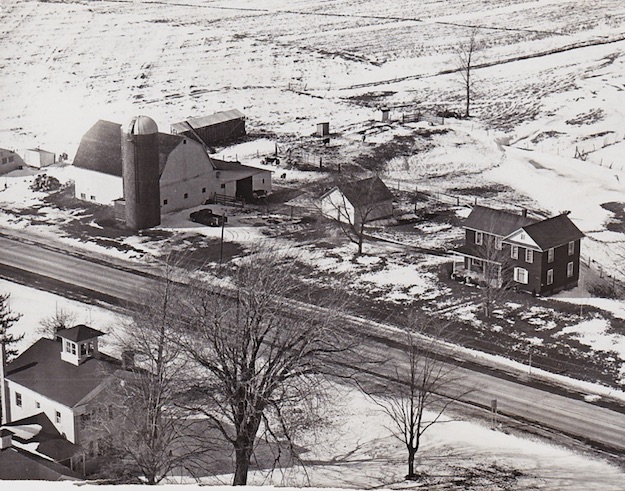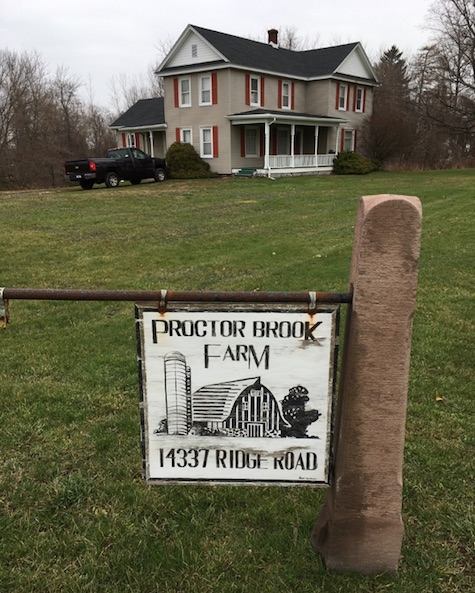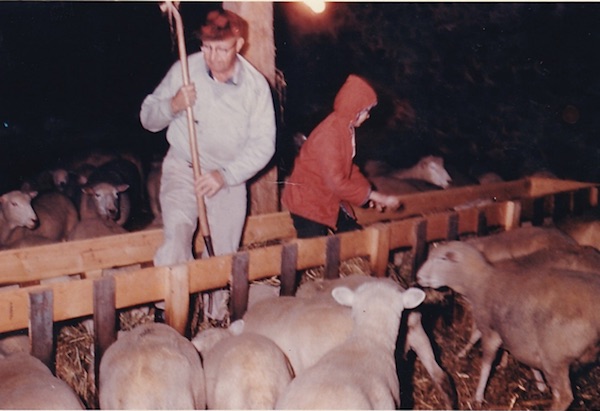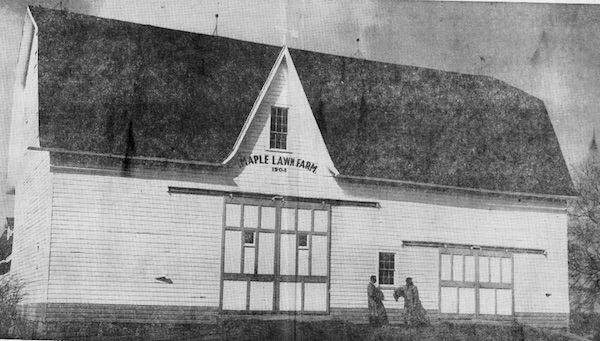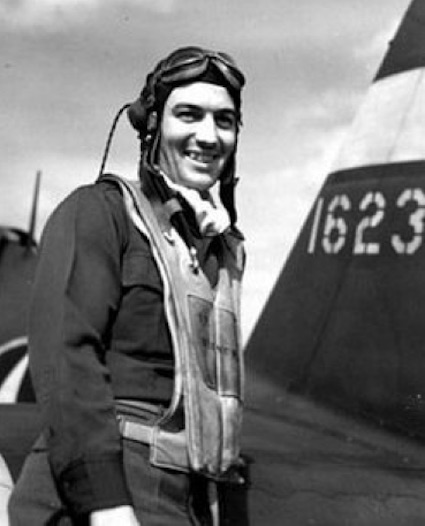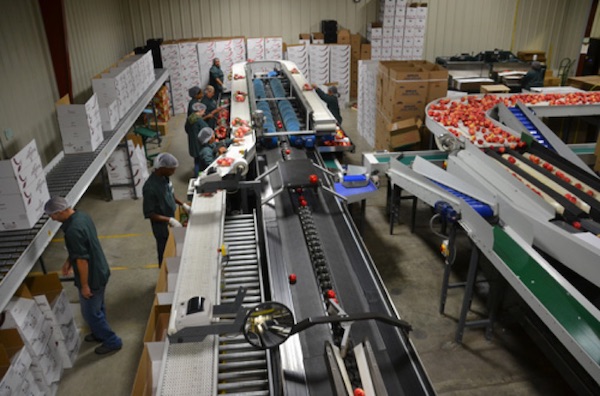Historic Childs: Agriculture has been a leading industry in the hamlet (part 1)
By Doug Farley, Cobblestone Museum Director
GAINES – The Hamlet of Childs has a long history of agriculture on both the north and south sides of Ridge Road and the adjoining properties on Oak Orchard Road. Some of the original families that farmed the land or processed the farm products, are still involved in farming, but most have sold their interests to other businesses as smaller family farms gave way to larger corporations. Over the next several articles we will look at many of those local farms.
John and Neva Dahlquist Murray were one of the farm families in the Hamlet of Childs. They were married in the mid-1920s. Their farm (pictured above) surrounded the old John Proctor homestead on the south side of the Ridge and encompassed a region running about one mile along Oak Orchard Road (Route 98) heading south out of the Hamlet.
The farm also extended to the north side of the Ridge. John and Neva had two children: Beverly June Murray Leigh and son John (Jack) Riley Murray, who went to work for the Gas Company following his service as a medic in the Korean War.
All in all, the John Murray family, which included his son-in-law Eugene Leigh, who married John’s daughter Beverly in 1946, farmed about 300-400 acres into the 1980s, which included some muck land in Elba. Their principal tree crops were apples, cherries, pears and peaches, as well as truck farming crops of corn, tomatoes, cabbage, soy beans and cucumbers. Bev and Gene Leigh moved into the farm house (shown above) when they were married in 1946 and Gene still lives there today, although the barns are now gone.
Bev Leigh named the family farm, “Proctor Brook Farm” after her parents died. Bev and Gene Leigh had three children: Valerie Leigh Hatch, Meredith Leigh Minier and John Murray Leigh.
A sign, shown above, still marks the driveway of the farm homestead today. The stone tie up for horses that it is attached to is also an object of fond remembrance for the family. Meredith said, “My sister and I used to hang from it upside down years ago. Mom brought it over to her place when Grandma died and I hope to do the same someday to keep it in the family.”
Proctor Brook Farm also raised animals including sheep, cows, pigs and horses. Gene’s daughter Meredith Minier (above right) recalls that her grandfather, John Murray (above left), took care of the sheep, and her father, Gene Leigh, took care of the cows. Meredith said, “Grandpa had work horses in his barn, too, until I was about three, I believe, and then we must have gotten a tractor!!”
She said her grandpa used to train sulky horses as a young man before he farmed and she remembers having a pleasure horse for a time, but when her grandfather had retina surgery they had to sell it because he couldn’t ride anymore.
Meredith said, “I remember writing my mother the first month I was married and had moved to Denver, because I couldn’t believe I had to pay 99 cents for a bag of apples in 1974!” John and Neva had a beautiful summer garden. Meredith recalled, “Grandpa would often leave a cantaloupe on our back step for us for breakfast in the summer. All the fruits and vegetables we could imagine and beef all the time too.”
Her Grandma and Grandpa also had lovely flowers with sweet peas being her favorite. “I remember Grandma bringing over bouquets of sweet peas, she had so many, and lilacs, too. Some things you don’t understand or appreciate until you are older!”
Meredith reflected further on her childhood memories:
“My memories are many and I was so fortunate for what they provided us. Dad worked sunrise to sunset seven days a week; he ran in at lunch and ate in ten minutes and back outside. He would fix his own equipment and send my Mom to the John Deere store for parts. I remember my Grandpa walking over one day in the summer holding his arm – he had caught it in the hay baler and off he and Mom went to the hospital with a broken arm! And my Dad was on the combine going south around the corner of 98 and 104 when the combine started on fire and Dad had to jump off onto the road to escape, 8-10 feet onto the pavement. He couldn’t walk for several days and has suffered from that injury since then. Mom was a wonderful farm wife, raising three children while Dad worked to provide for us; she could cook, can, sew, decorate, do the outside work, even make most of my sister and my clothes from dresses to coats and took up quilt making as we left the house and she had more time. All this as she lovingly raised a special needs son. Even in the days of modernization as it was in the ’50s and ’60s and ’70s it was not an easy life.”
The story of how John Murray got his start in farming is also very interesting. When John was growing up in the early 1900s, his father, George, owned property that they farmed on the north side of the Ridge Road by Brown Street Road. George acquired his farm in 1895 from the Miller Family who acquired it from the Rowley Family, who were early settlers to the area. When George Murray died in 1932, he left the family farm to his oldest son Curtis, which was the usual way property was passed down during that time period. However, “Curt” was indeed his brother’s keeper, in that he took a mortgage on his inherited property and gave some of the proceeds to his younger brother John, so he could buy a farm. John then bought the John Proctor farm located about a mile west on Ridge Road and his property became known as Proctor Brook Farm as previously described.
After his act of brotherly love, Curtis Murray (shown above right) carried on the farming legacy on George Murray’s property located on the north side of the Ridge by Brown Street Road. Curt’s farm was known as “Maple Lawn Farm,” named after a row of maple trees that once lined the property.
The Curtis Murray family was involved in dairying, and sold cream and butter on the farm. They also grew cash crops like cabbage, corn, and cucumbers. Curt’s daughter, Janice Mann Beech, recalls when her father removed an old barn on the property. She said, “To do that he hired an explosive expert to take down a free standing silo next to the barn. It took three attempts with dynamite to finally knock it down.”
Later, a parcel from Maple Lawn Farm was sold to the Gaines Carlton Community Church for their new building in 1969.
Farming in the “western end” of Childs can be traced to 1816 when the Hutchinson family acquired land on the south side of the Ridge from Holland Land Company. Hutchison progeny carried on the farming tradition into the 20th century when his daughter Florence married Everett Barnum and took over the farm.
Everett Barnum had planned on passing the farm down to one of his two sons, but fate had another plan. Both sons, Eugene and William, went off to war during WWII and neither returned alive from the war in Europe. 2nd Lt. William Barnum and Capt. Eugene Everett Barnum, Jr. (shown above) were buried next to each other in the Netherlands American Cemetery, Limburg Netherlands.
In 1958, Robert Schwartz, Jr. purchased the 100-acre Barnum farm, which he expanded to 160 acres. The Schwartz purchase marked the first time the farm had been out of the extended Hutchinson family since the early 1800s. The Schwartz farm raised dairy cattle along with fruit and vegetables. Robert’s daughter Linda Schwartz said her dad “always grew a cash crop, too.” Robert had three daughters, and without a son to pass his property on to, he sold the farm in 1984 to Dave Kast, Town of Gaines.
Dave Kast used some of the land to start Lake Ridge Fruit and its subsidiary Lake Ontario Fruit, one of the largest apple packing and storage facilities in the Northeast. Dave was one of the original 11 investors that started the plant in the 1980s. This multi-million dollar business has its own incredible story and will be the subject of another article in the near future.


























